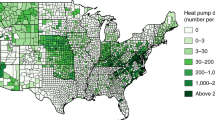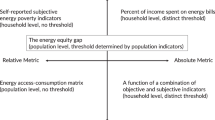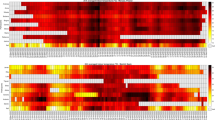Abstract
Adopting clean energy technologies offers households a viable solution to overcome energy insecurity. Heat pumps contribute to this potential by reducing energy expenses and increasing energy services. We examine the role of adopting heat pumps in mitigating energy insecurity, utilizing electricity records from 8,656 households in Phoenix, Arizona. We use a thermal comfort index to examine a household’s energy-limiting behaviour using a temperature–electricity response function. Our regression results show that households with heat pumps initiate cooling at 0.996 °C lower than those without and consume 0.476 kWh less electricity daily per degree increase in temperature. It indicates that heat pumps improve indoor comfort by activating earlier summer cooling. Cost savings from operation have a rebound effect of enabling greater comfort. Furthermore, this adoption reduces the energy equity gap across income groups, resulting in more similar and comfortable cooling start temperatures. This study supports the adoption of clean technologies to reduce energy insecurity.
This is a preview of subscription content, access via your institution
Access options
Access Nature and 54 other Nature Portfolio journals
Get Nature+, our best-value online-access subscription
$32.99 / 30 days
cancel any time
Subscribe to this journal
Receive 12 digital issues and online access to articles
$119.00 per year
only $9.92 per issue
Buy this article
- Purchase on SpringerLink
- Instant access to full article PDF
Prices may be subject to local taxes which are calculated during checkout






Similar content being viewed by others
Data availability
The raw household smart meter data and residential survey data are not publicly available due to a non-disclosure agreement but can be accessed upon reasonable request to the authors and with permission from the Salt River Project. Historical weather data are open access and can be obtained from the ‘GSODR’ package in R, following the code provided. Source data are provided with this paper.
Code availability
All data, models and figures are processed in R studio (version 4.3.1) and Stata. The code used to perform the data analysis is available via Github at https://github.com/yxf-993/Technology_Adoption.git.
References
Hernández, D. Understanding ‘energy insecurity’ and why it matters to health. Soc. Sci. Med. 167, 1–10 (2016).
US EIA. U.S. energy insecure households were billed more for energy than other households; https://www.eia.gov/todayinenergy/detail.php?id=56640 (2023).
Bednar, D. J. & Reames, T. G. Recognition of and response to energy poverty in the United States. Nat. Energy 5, 432–439 (2020).
Bednar, D. J. & Reames, T. G. Fleeting energy protections: state and utility level policy responses to energy poverty in the United States during COVID-19. Energy Res. Social Sci. 99, 103045 (2023).
Cong, S., Nock, D., Qiu, Y. L. & Xing, B. Unveiling hidden energy poverty using the energy equity gap. Nat. Commun. 13, 2456 (2022).
Huang, L., Nock, D., Cong, S. & Qiu, Y. L. Inequalities across cooling and heating in households: energy equity gaps. Energy Policy 182, 989–998 (2023).
Wang, Q., Kwan, M. P., Fan, J. & Lin, J. Racial disparities in energy poverty in the United States. Renew. Sustain. Energy Rev. 137, 103292 (2021).
Min, Y. & Mayfield, E. Rooftop solar, electric vehicle, and heat pump adoption in rural areas in the United States. Energy Res. Social Sci. 105, 103292 (2023).
Qiu, Y., Kahn, M. E. & Xing, B. Quantifying the rebound effects of residential solar panel adoption. J. Environ. Econ. Manage. 96, 310–341 (2019).
Zhao, D., McCoy, A. P., Du, J., Agee, P. & Lu, Y. Interaction effects of building technology and resident behavior on energy consumption in residential buildings. Energy Build. 134, 223–233 (2017).
Department of Energy. Heat pumps keep homes warm and bills low this winter; https://www.energy.gov/policy/articles/heat-pumps-keep-homes-warm-and-bills-low-winter (2023).
IEA. Tracking clean energy progress 2023 – analysis; https://www.iea.org/reports/tracking-clean-energy-progress-2023 (2023).
Davis, L. The economic determinants of heat pump adoption. SSRN https://doi.org/10.2139/ssrn.4483647 (2023).
de Querol Cumbrera, F. U.S. air-source heat pump shipments 2024. Statista https://www.statista.com/statistics/220358/air-source-heat-pump-shipments-in-the-us-since-2001/ (10 April 2025).
Brown, H. C. EVs, heat pumps saw continued sales growth at the end of 2024. Wall Street Journal (22 January 2025).
US Census Bureau. Distribution of residential heating fuel consumed in Arizona in 2022, by type. Statistica https://www.statista.com/statistics/1231022/residential-heating-fuel-distribution-in-arizona/ (2024).
Lagomarsino, M., van der Kam, M., Rahmani Azad, Z., Parra, D. & Hahnel, U. J. J. Co-adoption pathways toward a low-carbon energy system. iScience 26, 107815 (2023).
Streimikiene, D. Renewable energy technologies in households: challenges and low carbon energy transition justice. Econ. Sociol. 15, 616–628 (2022).
Mills, B. & Schleich, J. Residential energy-efficient technology adoption, energy conservation, knowledge, and attitudes: an analysis of European countries. Energy Policy 49, 616–628 (2012).
Shen, X., Liu, P., Qiu, Y. L., Patwardhan, A. & Vaishnav, P. Estimation of change in house sales prices in the United States after heat pump adoption. Nat. Energy 6, 30–37 (2021).
Shen, X., Qiu, Y. L., Liu, P. & Patwardhan, A. The Effect of Rebate and Loan Incentives on Residential Heat Pump Adoption: Evidence from North Carolina. Environmental and Resource Economics Vol. 82 (Springer Netherlands, 2022).
Memmott, T., Carley, S., Graff, M. & Konisky, D. M. Sociodemographic disparities in energy insecurity among low-income households before and during the COVID-19 pandemic. Nat. Energy 6, 186–193 (2021).
Semple, T. et al. An empirical critique of the low income low energy efficiency approach to measuring fuel poverty. Energy Policy 186, 152893 (2024).
Hiruta, Y., Gao, L. & Ashina, S. A novel method for acquiring rigorous temperature response functions for electricity demand at a regional scale. Sci. Total Environ. 819, 2705–2721 (2022).
Bessec, M. & Fouquau, J. The non-linear link between electricity consumption and temperature in Europe: a threshold panel approach. Energy Econ. 30, 1886–1891 (2008).
Auffhammer, M., Baylis, P. & Hausman, C. H. Climate change is projected to have severe impacts on the frequency and intensity of peak electricity demand across the United States. Proc. Natl Acad. Sci. USA 114, 38–47 (2017).
Hashimoto, Y. et al. Sensitivity of electricity consumption to air temperature, air humidity and solar radiation at the city-block scale in Osaka, Japan. Sustain. Cities Soc. 45, 1634–1645 (2019).
Ihara, T., Genchi, Y., Sato, T., Yamaguchi, K. & Endo, Y. City-block-scale sensitivity of electricity consumption to air temperature and air humidity in business districts of Tokyo, Japan. Energy 33, 1034–1049 (2008).
Krese, G., Lampret, Ž., Butala, V. & Prek, M. Determination of a building’s balance point temperature as an energy characteristic. Energy 165, 1034–1049 (2018).
Li, H. X., Horan, P., Luther, M. B. & Ahmed, T. M. F. Informed decision making of battery storage for solar-PV homes using smart meter data. Energy Build. 198, 491–502 (2019).
Jones, A., Nock, D., Samaras, C., Qiu, Y. L. & Xing, B. Climate change impacts on future residential electricity consumption and energy burden: a case study in Phoenix, Arizona. Energy Policy 183, 113811 (2023).
Kwon, M. et al. Forgone summertime comfort as a function of avoided electricity use. Energy Policy 183, 113813 (2023).
Castaño-Rosa, R. & Okushima, S. Prevalence of energy poverty in Japan: a comprehensive analysis of energy poverty vulnerabilities. Renewable Sustain. Energy Rev. 145, 111006 (2021).
Seddighi, S., Anthony, E. J., Seddighi, H. & Johnsson, F. The interplay between energy technologies and human health: Implications for energy transition. Energy Reports 9, 5592–5611 (2023).
Deetjen, T. A., Walsh, L. & Vaishnav, P. US residential heat pumps: the private economic potential and its emissions, health, and grid impacts. Environ. Res. Lett. 16, 80–92 (2021).
Patteeuw, D., Henze, G. P. & Helsen, L. Comparison of load shifting incentives for low-energy buildings with heat pumps to attain grid flexibility benefits. Appl. Energy 167, 80–92 (2016).
IEA. The Future of Heat Pumps (2022).
Gillingham, K., Rapson, D. & Wagner, G. The rebound effect and energy efficiency policy. Rev. Environ. Econ. Policy 10, 68–88 (2016).
Exadaktylos, F. & van den Bergh, J. Energy-related behaviour and rebound when rationality, self-interest and willpower are limited. Nat. Energy 6, 1104–1113 (2021).
US Department of Energy. Heat pump systems; https://www.energy.gov/energysaver/heat-pump-systems (accessed 23 September 2025).
Carley, S. & Konisky, D. M. The justice and equity implications of the clean energy transition. Nat. Energy 5, 569–577 (2020).
Elmallah, S., Crespo Montañés, C. & Callaway, D. Who heats and cools? Access to residential heating and cooling in Northern California and implications for energy transitions. Energy Policy 191, 114169 (2024).
Wang, Y. & Bielicki, J. M. Acclimation and the response of hourly electricity loads to meteorological variables. Energy 142, 111006 (2018).
Long, Y. et al. Unequal age-based household emission and its monthly variation embodied in energy consumption – a cases study of Tokyo, Japan. Appl. Energy 247, 350–362 (2019).
Cong, S., Ku, A. L., Nock, D., Ng, C. & Qiu, Y. L. Comfort or cash? Lessons from the COVID-19 pandemic’s impact on energy insecurity and energy limiting behavior in households. Energy Res. Social Sci. 113, 103528 (2024).
Bardazzi, R. & Pazienza, M. G. When I was your age: generational effects on long-run residential energy consumption in Italy. Energy Res. Social Sci. 70, 103141 (2020).
Mohamed, S., Smith, R., Rodrigues, L., Omer, S. & Calautit, J. The correlation of energy performance and building age in UK schools. J. Build. Eng. 43, 900–912 (2021).
Bollinger, B. & Gillingham, K. Peer effects in the diffusion of solar photovoltaic panels. Mark. Sci. 31, 597–620 (2012).
Gillingham, K., Newell, R. G. & Palmer, K. Energy efficiency economics and policy. Annu. Rev. Resour. Econ. 1, 597–620 (2009).
Jaffe, A. B., Newell, R. G. & Stavins, R. N. Environmental policy and technological change. Environ. Resour. Econ. 22, 41–70 (2002).
Acknowledgements
We acknowledge support from the Alfred P. Sloan Foundation.
Author information
Authors and Affiliations
Contributions
Y.L.Q. and D.N. jointly designed the research and revised the manuscript. X.Y. performed the research and wrote and revised manuscript. B.X. provided access to the electricity consumption data and institutional support.
Corresponding author
Ethics declarations
Competing interests
The authors declare no competing interests.
Peer review
Peer review information
Nature Energy thanks Yohan Min, Dorothée Charlier and Narasimha Rao for their contribution to the peer review of this work.
Additional information
Publisher’s note Springer Nature remains neutral with regard to jurisdictional claims in published maps and institutional affiliations.
Extended data
Extended Data Fig. 1 Three-step workflow to assess energy insecurity and heat pump impacts.
Step 1 involves matching each household’s electricity usage data and survey data with the nearest monitoring station’s temperature records. In Step 2, we calculate the energy burden and use the temperature response function to compute thermal comfort indicators, thereby identifying the energy insecurity level. In Step 3, we analyze the data to explore the effect of clean energy technologies adoption using a random effect panel data regression model, incorporating whether households have adopted clean energy technologies.
Extended Data Fig. 2 Plot of observed data and fitted piecewise linear regression for one household (ID = 441005, Year =2019, R² = 0.8744).
The scatter points represent actual daily electricity consumption, and the fitted segmented regression model is shown as a solid blue line. The red dashed vertical lines indicate the fitted balance points at 17.11 °C and 26.44 °C.
Extended Data Fig. 3 Illustration of the temperature response relationships.
(a) A U-shape temperature response function with two balance points is well-suited for households that use electricity for both cooling and heating. (b) A segmented function with a single balance point is applicable to households with electric cooling and gas heating. (c) A segmented function with two cooling balance points is applicable to households with electric cooling and gas heating.
Extended Data Fig. 4 Spatial distribution of Heating, Ventilation, and Air Conditioning (HVAC) contractors in the research area (EPSG:4326).
The map shows the study region, with brown polygons representing 92 ZIP Code areas across 22 county-level jurisdictions. Blue dots indicate the locations of HVAC contractors. Each point indicates the location of an individual contractor, geocoded based on publicly available address information (Google Maps). Specifically, we searched for businesses categorized as “HVAC contractors” or “air conditioning contractors” within 22 counties in Arizona that overlap with our study area of 8,656 households. We manually recorded business names and addresses and geocoded the coordinates using the geocode() function in R (with OpenStreetMap as the base source). ZCTA shapefiles from the US Census Bureau (https://www.census.gov/geographies/mapping-files/time-series/geo/tiger-line-file.html).
Supplementary information
Supplementary Information
Supplementary Notes 1–3, Figs. 1–11, Tables 1–16 and reference.
Source data
Source Data Fig. 1
This dataset contains energy spending records by income group and heat pump adoption status. The raw data are processed, and we compute the first quartile (Q1), median (Q2) and third quartile (Q3) of energy costs for each group by Income and Heat pump. These statistics are used to construct the box boundaries in the plots.
Source Data Fig. 2
This Excel file contains the source data used to generate the boxplots shown in Fig. 2. Each row corresponds to an individual household thermal comfort indicators generated from piecewise linear regression. To protect privacy, all individual identifiers have been removed from the dataset.
Source Data Fig. 3
Baseline regression statistical results.
Source Data Fig. 4
IV regression statistical results.
Source Data Fig. 5
Heterogeneity (Income) regression statistical results.
Source Data Fig. 6
Heterogeneity (Ethnic) regression statistical results.
Source Data Extended Data Fig. 2
Key regression outputs for the household shown in Extended Data Fig. 2 (ID: 441005), including the estimated breakpoints and segment-specific slopes from the piecewise linear regression model, as well as standard errors and confidence intervals.
Source Data Extended Data Fig. 4
Spatial distribution data for HVAC contractors within the study region.
Rights and permissions
Springer Nature or its licensor (e.g. a society or other partner) holds exclusive rights to this article under a publishing agreement with the author(s) or other rightsholder(s); author self-archiving of the accepted manuscript version of this article is solely governed by the terms of such publishing agreement and applicable law.
About this article
Cite this article
Ye, X., Qiu, Y.L., Nock, D. et al. The comfort rebound from heat pumps and impact on household cooling behaviour and energy security. Nat Energy 10, 1166–1177 (2025). https://doi.org/10.1038/s41560-025-01845-2
Received:
Accepted:
Published:
Issue date:
DOI: https://doi.org/10.1038/s41560-025-01845-2



